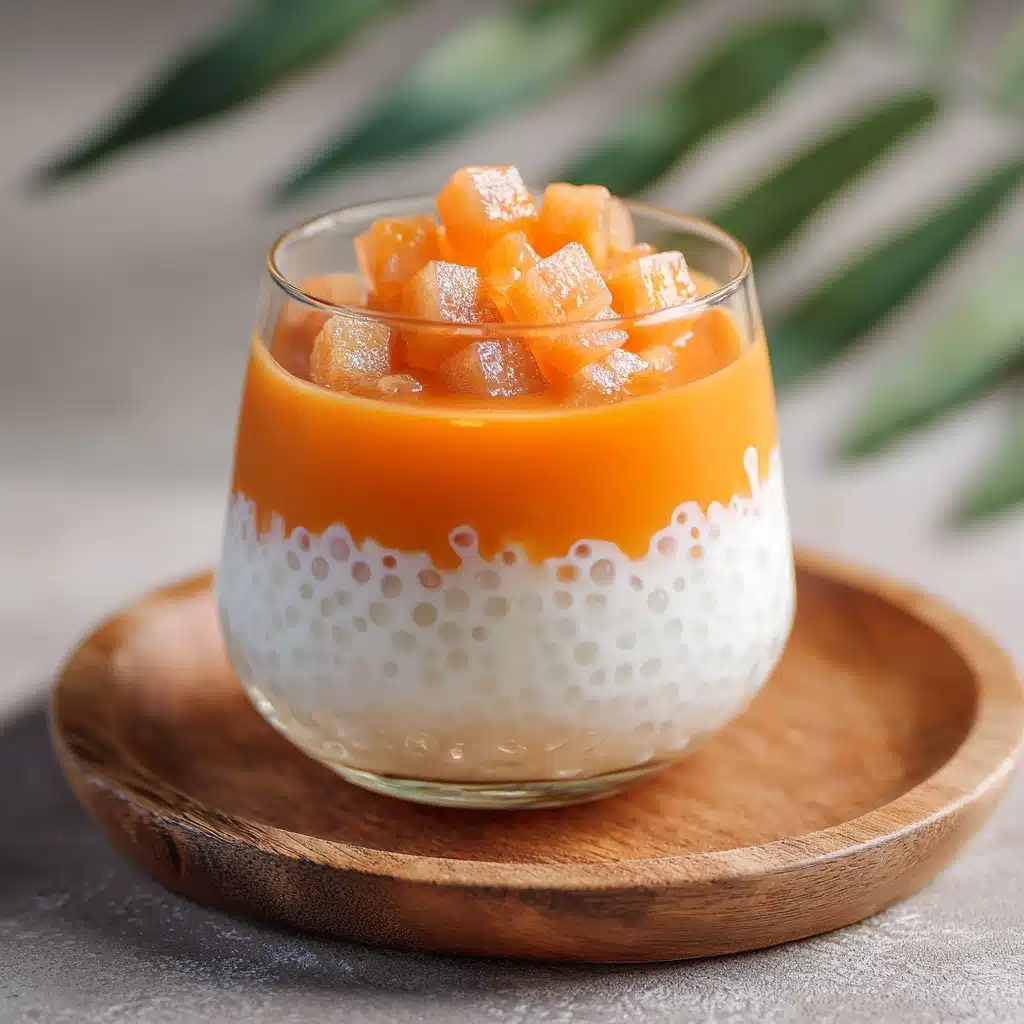Mango Sago Recipe
If you’re craving a dessert that’s refreshingly sweet, creamy, and bursting with vibrant tropical flavors, look no further than Mango Sago. This irresistible Asian treat combines tiny, chewy sago pearls with luscious coconut milk and fresh mango puree, finished off with juicy mango chunks that create a perfect balance of textures and tastes. It’s simple to whip up, wonderfully light yet satisfying, and an absolute crowd-pleaser when the weather heats up. Trust me, once you try this Mango Sago, it will become your go-to indulgence during warm days and festive occasions alike.

Ingredients You’ll Need
With just a handful of humble ingredients, this Mango Sago delivers an extraordinary flavor and texture experience. Each component plays a crucial role, whether it’s the creamy richness from the coconut milk or the sweet brightness of ripe mangoes that bring the dish to life.
- 1 cup sago pearls: These tiny pearls provide that signature, delightfully chewy texture essential to Mango Sago.
- 14 fluid ounces full-fat coconut milk: This adds a luscious creaminess and subtle tropical aroma that ties everything together.
- 2 tablespoons honey: A natural sweetener that enhances the mango’s fruity flavor without overpowering it.
- 2 tablespoons granulated sugar: Balances sweetness perfectly, but feel free to adjust or substitute with more honey if you prefer!
- 4 ripe mangoes (yellow, champagne, or honey mangoes recommended): The star ingredient for that juicy, fresh mango intensity in every bite.
- 3 cups ice cubes (optional): For serving chilled, making this dessert cool and refreshing on a hot day.
- Optional add-ons: Coconut jelly, mango pudding, or boba pearls can add an exciting twist and extra dimension.
How to Make Mango Sago
Step 1: Cook the Sago Pearls
Start by bringing a large pot of water to a rolling boil. Add the sago pearls carefully while stirring continuously to prevent sticking. Cook according to the package directions, usually around 10 to 15 minutes, until the pearls turn almost transparent with just a tiny white dot in the center. Stir frequently and make sure there’s plenty of water, as sago expands and thickens the water. Once cooked, drain and rinse immediately with cold water—this cool rinse stops the cooking process and makes the pearls perfectly clear and delightfully chewy.
Step 2: Prepare the Coconut Milk Mixture
While the sago cooks, combine the full-fat coconut milk, honey, and granulated sugar in a bowl. Stir gently until the sugar dissolves completely. You can refrigerate this mixture to keep it cool and let the flavors meld while you finish the other steps.
Step 3: Make the Mango Puree and Dice Mango
Peel all four mangoes carefully, then dice two mangoes into small, juicy cubes to provide delightful bites throughout the dessert. For the other two mangoes (and the residual flesh around the seeds), blend everything until silky smooth to achieve a luscious mango puree that forms the flavorful base of the dish.
Step 4: Assemble Your Mango Sago
In a large bowl, combine the drained sago pearls, diced mango pieces, mango puree, and any optional add-ons you love, such as coconut jelly or boba pearls. Pour in the sweetened coconut milk mixture along with ice cubes if you want it chilled. Stir everything gently until it’s beautifully blended and well chilled. For a stunning presentation, try layering mango puree, then the coconut milk sago mixture, and top with diced mangoes in your serving bowls or cups.
How to Serve Mango Sago

Garnishes
The beauty of Mango Sago lies not only in its taste but also in its inviting appearance. Top with fresh mango cubes to add bursts of sweetness, or sprinkle a few coconut flakes for extra texture and tropical flair. A sprig of mint can also brighten the look and add a subtle hint of freshness to each spoonful.
Side Dishes
This sweet treat pairs wonderfully with light snacks and drinks. Consider serving Mango Sago alongside crispy sesame prawn crackers or a refreshing iced jasmine tea to balance the creaminess and sweetness. Since Mango Sago is already rich and filling, keeping sides light enhances your overall meal experience without overwhelming the palate.
Creative Ways to Present
For an elegant touch, serve Mango Sago in clear glass cups or petite mason jars, allowing the colorful layers of mango and creamy coconut to shine. For parties, try individual servings topped with colorful edible flowers or a drizzle of passion fruit syrup for an exotic twist. You can even freeze portions into popsicles, making a fun frozen version of this beloved dessert.
Make Ahead and Storage
Storing Leftovers
Mango Sago can be stored in an airtight container in the refrigerator for up to 2 days. Be aware that the sago pearls might thicken slightly after sitting, so give the dessert a gentle stir before serving. To keep the mango chunks fresh, it’s best to add them right before eating if possible.
Freezing
Freezing Mango Sago isn’t typically recommended because the texture of the sago pearls changes with freezing and thawing, often becoming hard or uneven. However, the mango puree can be frozen separately and thawed later to keep on hand for fresh preparation.
Reheating
If you prefer warming your Mango Sago slightly, gently heat only the coconut milk mixture before stirring it back with cooled sago and fresh mangoes—avoid microwaving the entire dessert to prevent uneven warming or cooked mango texture changes. Remember, Mango Sago truly shines as a cool, refreshing treat!
FAQs
What exactly are sago pearls?
Sago pearls are tiny starch balls extracted from the pith of tropical palm stems. They have a unique chewy texture and become translucent when cooked, making them perfect for desserts like Mango Sago.
Can I use frozen mangoes instead of fresh?
Absolutely! Frozen mangoes work fine for making the puree and even for adding diced pieces, just thaw and drain any extra juice to avoid watering down the dish.
Is Mango Sago suitable for vegans?
Yes, Mango Sago is naturally vegan as long as you use plant-based sweeteners like agave or pure maple syrup instead of honey. The coconut milk ensures creamy richness without dairy.
Can I substitute sago pearls with tapioca pearls?
They are very similar, so tapioca pearls can be used as a substitute. Just follow the package instructions as cooking times may differ slightly.
How sweet should Mango Sago be?
The sweetness depends on your mangoes and personal taste. Start with the recommended amounts of sugar and honey, taste, and then adjust accordingly. Ripe mangoes are naturally sweet, so you might need less added sugar.
Final Thoughts
I truly hope you give this delightful Mango Sago a try—it’s one of those rare desserts that feels like summer sunshine in every spoonful. Its refreshing creaminess, vibrant tropical flavors, and comforting texture make it an absolute joy to enjoy and share. Whether you’re treating yourself on a warm afternoon or serving it at gatherings, Mango Sago will always bring smiles and satisfy those sweet cravings with a splash of tropical magic.





